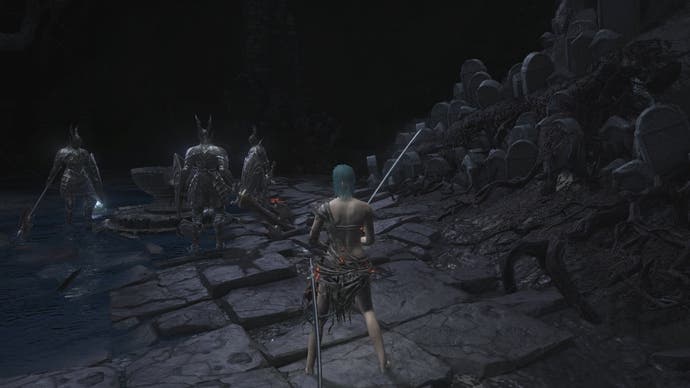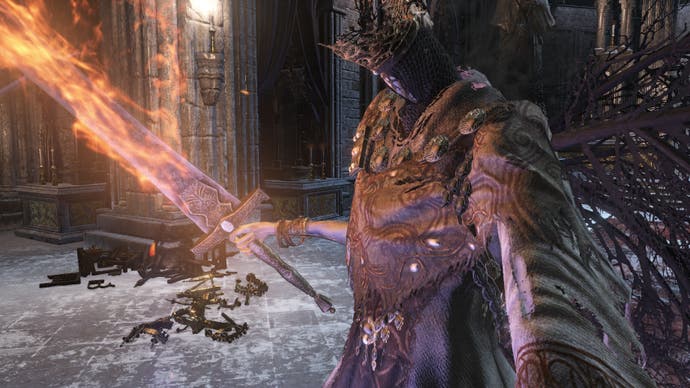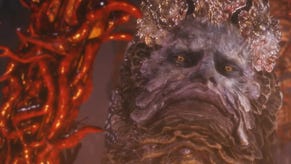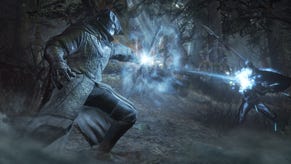Fans are finding clues pointing to a very different, earlier version of Dark Souls 3
Pontiff Sulyvahn as the final boss, and more.
Fans have been piecing together a version of Dark Souls 3 very different to the one seen at release, combining pre-launch accounts of the game and source code plundering in an effort to reconstruct From Software's original vision.
It all begins with evidence uncovered by longtime From Software fan and source code sleuth Lance McDonald, who previously made some fascinating discoveries regarding cut content in Bloodborne. Be warned that Dark Souls 3 spoilers occur from here on out.
According to game file references unearthed by McDonald, at one stage in development, Dark Souls 3 didn't conclude with the fight against the Soul of Cinder in the Kiln of the First, as is the case in the final release. Instead, it culminated in a battle with Pontiff Sulyvahn (now found in Irithyll of the Boreal Valley) in an unseen third variation of the Untended Graves.

In the final version of Dark Souls 3, the Untended Graves is a pitch black, entirely optional area (seemingly an alternate timeline version of the Cemetery of Ash and Firelink Shrine that opens the game), and is accessed after the Oceiros boss fight, in the garden below Lothric Castle.
In a series of tweets, however, MacDonald explained that code references point to there being three distinct versions of the Cemetery of Ash/Untended Graves area at one stage. Alongside the familiar daylight and nighttime iterations seen in the full release, there was a third variant - these are labelled "default", "eroded", and "last boss" respectively, within the game's files.
From what McDonald has deduced, it was originally planned that players could perform some sort of ceremony to switch between the three versions of the area, changing the time of day on-the-fly, with a unique boss encounter found in each.
Champion Gundyr (also referred to Old Old Hero Gunda in the code) would seemingly still be found in the default, daylight version of the Untended Graves area, as currently seen at the start of the game, with another now-completely-removed boss - referred to as both Evil Spirits and Snake Soul - occupying the dark, eroded version. Pontiff Sulyvahn, at one point known as the Black Old King, would appear in the third, Last Boss variant.
Interestingly, McDonald's revelations jogged the memory of another Twitter user, Eduardo Pratti, who recalled seeing a post from a (presumed) QA tester around the time of Dark Souls 3's release. Pratti managed to locate a copy of this early account and shared it with McDonald.
Not only does it appear to corroborate that Untended Graves was Dark Souls 3's original ending location, it offers a host of other, massive, pre-release differences, painting a surprisingly vivid picture of the game that Dark Souls 3 used to be. McDonald, for his part, says that he "can verify huge chunks" of the (unnamed) QA tester's account.
"Untended Graves was actually the beginning of a cut level that went all the way to Soul of Cinder through a ruined firelink and lower wall area", the tester explained. This, they say, was "filled with black knights to pay homage to the original [Dark Souls]". Happily, this description matches a screenshot that McDonald shared on Twitter, suggesting that the original poster's other assertions could very well be true.

For instance, the poster claimed that the Yhorm the Giant model encountered in the release version of Dark Souls 3's Profaned Capital was, at one stage in development, intended to be the first boss that players confronted - and was called Gundyr at the time. "The [starting] area was designed around Yhorm waking up from the coffin alongside you and he was a simple boss easing people into the game". This Yhorm would later reappear in a much harder guise - seemingly a reflection of the two Gundyr battles seen in Dark Souls 3's final release.
More interesting still is the claim that, at one point, the Yhorm the Giant encounter in the Profaned Capital utilised the towering skeleton boss that eventually became High Lord Wolnir in the Catacombs of Carthus. Supposedly, in his original - and properly giant - guise, Yhorm was a "gold obsessed mad skeleton optional boss and covenant leader of the Mound Makers".
More evidence supporting the details in the QA tester's account can be found in Dark Souls 3's official gameplay reveal trailer. Look carefully, and you can actually see what appears to be the Wolnir boss fight unfolding in final release's Profaned Capital Yhorm boss room.

Elsewhere, the QA tester suggested that snakes once played a much greater role in the game. "Twin Princes, in fact, the entire Lothric Castle area was at night," they explained, and [instead of Pilgrim Butterflies] there were serpents with wings flying around".
What's more, the giant hole seen in the Twin Princes boss area was apparently once the location where "Kaathe would fly in from in an encounter".

Given that McDonald found reference to a 'Snake Soul' boss fight, did From intend players to battle Dark Souls' Darkstalker Kaathe in the Untended Graves at one point? And is the serpentine creature seen in the still-mysterious leaked shot above related to the encounter?
One familiar boss that's currently unaccounted for in all of this, of course, is Gundyr. If Wolnir was originally Yhorm, and Yhorm was originally Gundyr, what role did Gundry-as-we-now-know-him fulfil? According to the poster, Gundyr was initially known as Old King Oceiros (his armour description apparently still refers to the Old King), and was found in the current Oceiros boss battle room, leading into the Untended Graves area.

As Pratti points out, Gundyr's placement would make a little more sense here given that he appears to be infected with the Pus of Man during his fight - an affliction that manifests in numerous enemies within the Consumed King's Garden area. All of which paints a surprisingly clear picture of how Dark Souls 3's late game might originally have been structured.
Incidentally, the miserable, tormented Oceiros seen in the final release was claimed to be a "post Bloodborne DLC change by C team to ape the Ludwig experience" - and, funnily enough, this later edition of Oceiros is not without his secrets either.
McDonald recently discovered that the mad king - inferred to have been driven insane by the death of his son Ocelotte in the final game - featured a rather more clear-cut back story. It appears that the boss was originally to be seen clutching his lifeless child throughout the battle - but this was removed for final release, presumably to avoid controversy.
Yet, it doesn't stop there, and the QA tester's account refers to numerous other fascinating differences between the in-development build of Dark Souls 3 and the one we finally saw:
- "Carthus Catacombs was originally accessed after Greatwood - where the altar is now, that was actually a doorway".
- "Smouldering Lake used to have a path up to Irithyll starting from the large crossbow, and met up with the broken stair section where you fight the Alva invader. This is also why the Pontiff Beast can appear either in the water or at the bridge, because originally there were two ways into Irithyll".
This particular claim appears to be supported by the fact that the Irithyll broken staircase can still be seen from the Smouldering Lake in the final game, although its placement makes no geographical sense. This is nicely demonstrated in the video below.
And how about a few more tidbits regarding the early days of Dark Souls 3 to round things off?
- "The entire area in Smouldering Lake with the crossbow was actually a boss arena where you would fight a giant bat, and you could crash through the ground to avoid the boss, and then use the crossbow to wound it - a combination of Dragon God and Kalameet mechanics, then phase two would be the giant worm appears".
- "Abyss Watchers led straight up to Irithyll's bridge area, Abyss Watchers themselves being much much harder than they are now with more health and damage".
- "Deacons of the Deep was originally a two phase and they had a cutscene and everything. Aldritch would flow out of the coffin and the fight would involve circling around the cube".
Of course, with no official word on any of this, it's impossible to know how far in development these reported variations of Dark Souls 3 were. Still though, it's a fascinating glimpse at a game that we'll likely never seen - and the lore implications alone are enough to make my head spin.








